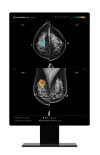Screening Black women for breast cancer at 40 cuts racial disparities in mortality in half
by John R. Fischer, Senior Reporter | November 04, 2021
Women's Health

Screening black women at 40 for breast cancer may help reduce racial disparities in survival and mortality outcomes compared to white women
Performing mammograms on Black women starting at age 40 may lead to more equitable survival outcomes between them and white women who begin screening at 50. That's what researchers from the Cancer Intervention and Surveillance Modeling Network are saying in a new study that found screening Black women at 40 reduced disparities in breast cancer deaths by 57%.
Current guidelines recommend women start getting mammograms biennially between 50 and 74 but do not take into account that Black women have higher rates of aggressive cancers at younger ages than white women and that treatment for those types are not as effective. They also do not consider the effects of racism in medicine.
Using self-reported race as a proxy, CISNET developed a model to look at those who are likely to be affected by racism. The model also accounted for breast density, distribution of breast cancer molecular subtypes, age-, stage- and subtype-specific treatment effects, as well as non-breast cancer mortality across races.
Looking at three biennial screening strategies at ages 40, 45 and 50, researchers compared the benefits and harms of different screening strategies for Black women to those for white women who started screening at age 50, based on the U.S. Preventive Services Task Force recommendations. They found that initiating mammograms for Black women at 40 reduced mortality the greatest and decreased mortality disparities by 57%.
Lead author Dr. Christina Hunter Chapman, adjunct assistant professor in the department of radiation oncology at the University of Michigan, said these racial disparities listed in the paper have been described for decades. “The presence of these disparities did not automatically mean that altering screening guidelines represented a viable solution. So more direct evidence was needed in the form of clinical trials or modeling studies (as we have now performed), but Black women were not included in sufficient numbers in the randomized trials of mammography that were done decades ago.”
The model projected the lifetime impact of digital mammography, considering different starting ages and intervals between screenings, for women who would be 40 in 2020. It compared the number of years gained by detecting cancer early, breast cancer deaths avoided, and mortality reduction, as well as harms such as undergoing a larger number of mammograms (annual versus every other year) and receiving false positives. Racial disparities evaluated included earlier age of onset, higher incidence of aggressive subtypes, higher mortality and worse receipt of modern treatment.
Current guidelines recommend women start getting mammograms biennially between 50 and 74 but do not take into account that Black women have higher rates of aggressive cancers at younger ages than white women and that treatment for those types are not as effective. They also do not consider the effects of racism in medicine.
Using self-reported race as a proxy, CISNET developed a model to look at those who are likely to be affected by racism. The model also accounted for breast density, distribution of breast cancer molecular subtypes, age-, stage- and subtype-specific treatment effects, as well as non-breast cancer mortality across races.
Looking at three biennial screening strategies at ages 40, 45 and 50, researchers compared the benefits and harms of different screening strategies for Black women to those for white women who started screening at age 50, based on the U.S. Preventive Services Task Force recommendations. They found that initiating mammograms for Black women at 40 reduced mortality the greatest and decreased mortality disparities by 57%.
Lead author Dr. Christina Hunter Chapman, adjunct assistant professor in the department of radiation oncology at the University of Michigan, said these racial disparities listed in the paper have been described for decades. “The presence of these disparities did not automatically mean that altering screening guidelines represented a viable solution. So more direct evidence was needed in the form of clinical trials or modeling studies (as we have now performed), but Black women were not included in sufficient numbers in the randomized trials of mammography that were done decades ago.”
The model projected the lifetime impact of digital mammography, considering different starting ages and intervals between screenings, for women who would be 40 in 2020. It compared the number of years gained by detecting cancer early, breast cancer deaths avoided, and mortality reduction, as well as harms such as undergoing a larger number of mammograms (annual versus every other year) and receiving false positives. Racial disparities evaluated included earlier age of onset, higher incidence of aggressive subtypes, higher mortality and worse receipt of modern treatment.
1(current)
You Must Be Logged In To Post A CommentRegisterRegistration is Free and Easy. Enjoy the benefits of The World's Leading New & Used Medical Equipment Marketplace. Register Now! |
|









